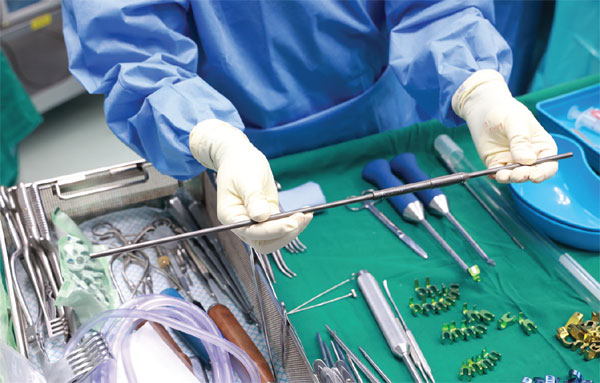HK-Shenzhen pulls off a first under medical connect
Pilot program
Cheung has been vigorously pitching the HKU-SZH - the only pilot hospital to implement the new connect policy so far - to include titanium rods in the first batch of medical equipment to cross the border. "Last year, as soon as I heard of the policy, I approached the Shenzhen hospital immediately," he recalled.
HKU-SZH, built and funded by the Shenzhen municipal people's government, is a public hospital in Shenzhen's Futian district and one of the University of Hong Kong's two teaching hospitals. When it opened in 2012, it was described as a key part of the overhaul of China's healthcare system.
In Hong Kong, an average of five to 10 similar operations are performed annually, but at least 10,000 children may need the equipment on the mainland.
"Our doctors will get more experience, along with more surgeries, so it's a boon for training," said Cheung. "As an academic center, we always hope to do research. The more cases, the richer the research results will be," said Cheung, who heads the orthopedics and traumatology unit at the University of Hong Kong.
Lo Chung-mau, chief executive of HKU-SZH, said Hong Kong could become a medical research hub, attracting cutting-edge biomedicine research projects from all over the world. "A paramount benefit for Hong Kong is to jointly research and develop new medical products."
For instance, a platform in a cross-border pilot zone could be set up to match new biomedicine technology developed by Hong Kong researchers with mainland institutions, and conduct clinical testing in the entire Greater Bay Area.

The titanium rod is the first medical device imported through the Hong Kong and Macao Medicine and Equipment Connect. [Photo provided to China Daily]
Moreover, he said the new channel can expand sales of medical companies. The hospital is purchasing a further 10 titanium rods. Each patient needs only one or two rods.
Lo said safety concerns will ensure the quantity won't be extremely large initially. "The titanium rod producer has agreed to provide the equipment on the mainland because they knew Professor Cheung would perform the surgery," he added, stressing the result of each case is important for the drug and medical equipment producers.
According to HKU-SZH, four other innovative medications have been approved and will soon be put into pilot use at the hospital, following the first drug and device applications.
The first imported medicine under the connect program is Rho(D) immune globulin - a blood disease drug that was used clinically at the hospital on April 29. In addition, the clinical data collected from these applications could also help expedite national approval for related international drugs or devices.
The marketing of many medicines in Hong Kong is synchronized with the world because of mutual recognition, but the mainland needs to do its own clinical results for review and approval, said Huo Peiqiong, general manager of China Resources Guangdong Pharmaceutical - the import agent for the first drugs and equipment.
So registering in Hong Kong or launching the products in the Hong Kong market is much faster than on the mainland, she noted. For example, one drug can be listed in Hong Kong simultaneously in the United States or the United Kingdom.
The connect gives the green light for medicines that are already available in Hong Kong and Macao markets, so more international pharmaceutical enterprises would seek registration there because entering the two special administrative regions mean they could tap the Greater Bay Area or the entire mainland market sooner.
However, it wasn't plain sailing for reviewing, purchasing and transporting the first batch of drugs and device through the connect. Huo recalled it took more than two months to have them delivered.
Many innovative measures were needed to lay a solid foundation for the potential expansion of the connect to more mainland cities. But in the absence of national approval, the import agent had to communicate back and forth between local evaluation authorities and pharmaceutical enterprises to provide proper materials for review.



 Print
Print Mail
Mail

